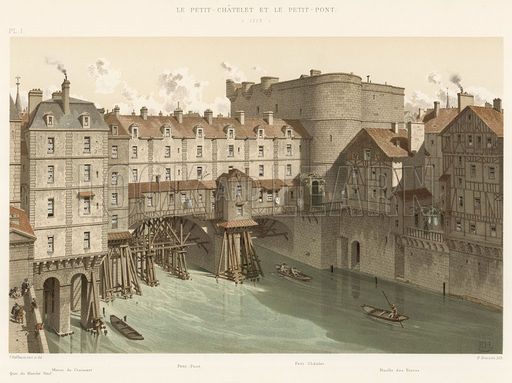The Petit Pont [The Little Bridge]
Sonia, Alison, and Rebecca Landes, Paris Walks (New York: Henry Holt, 2005), pp.5-6.
The Landes famly (mother, daughterm and graddaughter) have written an excellent walking guide to Paris. Below is an excerpt from their book. The Petit Pont, which they described, is between points B and C on our tour.
Starting Point: The comer of the Petit Pont and the quai de Montebello , 5th arrondissement
The site of the present church of Saint-Severin, the back of which you can see down the rue du Petit Pont on the right, was a small, dry hillock where a hermit chose to settle in the fifth century. Later, as the Seine continued to dig itself a deeper channel, the area between high ground and the river filled with houses and narrow paths.
Even as late as the Middle Ages, the street level was thirty feet (three stories) lower than it is today. This is why three levels of cellar still exist in the seventeenth-century buildings you see in the area. Until the middle of the nineteenth century the streets and alleys of the quartier ran steeply down to the river's edge.
The present ground-floor shops are on what was once the second floor of these buildings. Notice the thirty-foot embankment that rises from the Seine; where that stands, houses once stood.
The first bridge connecting the Ile de la Cite to the mainland, the present Petit Pont, was built here because at this point the island is closest to the Left Bank. A little  fortress, the Petit Chatelet , which doubled as a tollhouse , stood at the end of the bridge on the spot where you are now. It was the custom then, as it is today on some bridges, to pay a toll in order to pass in and out of the city. Another, larger, fortress , the Grand Chatelet, stood on the right bank of this part of the Seine, at the Pont Saint-Michel. Both these bastions were used as prisons during the French Revolution. With the help of underground passageways to many points in the vicinity, prison affairs could easily be carried on in secret.
fortress, the Petit Chatelet , which doubled as a tollhouse , stood at the end of the bridge on the spot where you are now. It was the custom then, as it is today on some bridges, to pay a toll in order to pass in and out of the city. Another, larger, fortress , the Grand Chatelet, stood on the right bank of this part of the Seine, at the Pont Saint-Michel. Both these bastions were used as prisons during the French Revolution. With the help of underground passageways to many points in the vicinity, prison affairs could easily be carried on in secret.
The Petit Pont was not only a passageway; two- and threestory houses and shops lined either side of it, making it the busiest street in town. In the Middle Ages the picturesque aspect of this bridge -- really a street thrown across the river – was enlivened by philosophers offering their intellectual wares and by jugglers, singers, and dog and bear trainers. During the day it was a paradise for cutpurses, at night for cutthroats. The bridge was rebuilt after fire, flood, and attack more times than the French care to count. Fire was the most common cause of its destruction until the eighteenth century, when the bridge was finally rebuilt in stone.
In the Middle Ages people believed that the bodies of those drowned in the Seine could be located by setting a votive candle on a wooden disc afloat in the river and noting where it stopped or went out. It was especially important to find drowned bodies before the authorities did, because a huge fee of 101 écus, the equivalent of a year 's pay for a manual laborer, is said to have been charged for the delivery of a loved one from the morgue at the Chatelet.
One story about this bridge and its fires has it that a poor old widow whose son had drowned set a candle afloat in hopes of finding his body. The candle floated close to a straw-laden barge, setting it on fire. The barge touched the wooden scaffolding of a pillar of the bridge, and from there the flames spread to the bridge itself. In three days, the raging fire destroyed the bridge and the houses on it.